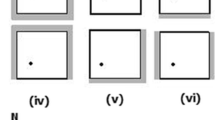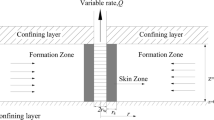Abstract
This work presents an analytical solution for the linearized Boussinesq equation describing the nature of well hydraulics in equilateral triangular-shaped unconfined aquifer. This homogeneous, isotropic, fully-saturated porous media is hydraulically connected to three surrounding streams of constant-head. The solution enables modeling aquifer response to a system of arbitrarily-located, fully-penetrating multiwells (injection, extraction or combination of both), each characterized by stepwise time-varying rate. First, a fundamental solution is provided for multiwell-induced head distribution in an infinite aquifer domain. Image well theory is then efficiently implemented to create an equivalent flow field for the intended domain. Spatiotemporal head distribution is obtained in the form of fivefold series involving exponential integrals. Expressions are also derived to quantify stream depletion rates caused by a single pumping well, under both transient and steady-state conditions. As a hypothetical example, an aquifer remediation scheme is planned by combining two extraction wells with an injection one. The computed head profiles reveal strictly close agreement with numerical results obtained by finite element method. Sensitivity map for stream depletion rate is also discussed. The present results are found to exactly reproduce those available for the wedge-shaped domain, under certain geometric constraint. Finally, the solution is extended to the case of hemi-equilateral triangular-shaped aquifer with or without an impervious boundary line.








Similar content being viewed by others
References
Abramowitz M, Stegun IA (1972) Handbook of mathematical functions with formulas, graphs, and mathematical tables, vol 9. Dover, New York
Asadi-Aghbolaghi M, Chuang MH, Yeh HD (2012) Groundwater response to tidal fluctuation in a sloping leaky aquifer system. Appl Math Model 36(10):4750–4759
Asadi-Aghbolaghi M, Rakhshandehroo GR, Kompani-Zare M (2011) Analytical solutions for the capture zone of a pumping well near a stream. Hydrogeol J 19:1161–1168
Asadi-Aghbolaghi M, Seyyedian H (2010) An analytical solution for groundwater flow to a vertical well in a triangle-shaped aquifer. J Hydrol 393(3):341–348
Bresciani E, Kang PK, Lee S (2019) Theoretical analysis of groundwater flow patterns near stagnation points. Water Resour Res 55(2):1624–1650
Butler JJ, Zhan X, Zlotnik VA (2007) Pumping-induced drawdown and stream depletion in a leaky aquifer system. Groundwater 45(2):178–186
Chang YC, Yeh HD (2007) Analytical solution for groundwater flow in an anisotropic sloping aquifer with arbitrarily located multiwells. J Hydrol 347(1):143–152
Erdélyi A (1954) Tables of integral transforms (Vol. I). McGraw-Hill, New York
Gander W, Gautschi W (2000) Adaptive quadrature—revisited. BIT Numer Math 40(1):84–101
Hunt B (1999) Unsteady stream depletion from ground water pumping. Groundwater 37(1):98–102
Kacimov AR, Kayumov IR, Al-Maktoumi A (2016) Rainfall induced groundwater mound in wedge-shaped promontories: the Strack–Chernyshov model revisited. Adv Water Resour 97:110–119
Kacimov AR, Maklakov DV, Kayumov IR, Al-Futaisi A (2017) Free surface flow in a microfluidic corner and in an unconfined aquifer with accretion: the Signorini and Saint-Venant analytical techniques revisited. Transp Porous Media 116(1):115–142
Lin CC, Chang YC, Yeh HD (2018) Analysis of groundwater flow and stream depletion in the L-shaped fluvial aquifer. Hydrol Earth Syst Sci 22(4):2359–2375
Mahdavi A (2019) Response of triangular-shaped leaky aquifers to rainfall-induced groundwater recharge: an analytical study. Water Resour Manag 33(6):2153–2173
Mahdavi A, Seyyedian H (2013) Transient-state analytical solution for groundwater recharge in triangular-shaped aquifers using the concept of expanded domain. Water Resour Manag 27(8):2785–2806
Mahdavi A, Seyyedian H (2014) Steady-state groundwater recharge in trapezoidal-shaped aquifers: a semi-analytical approach based on variational calculus. J Hydrol 512:457–462
Rai SN, Manglik A (2012) An analytical solution of Boussinesq equation to predict water table fluctuations due to time varying recharge and withdrawal from multiple basins, wells and leakage sites. Water Resour Manag 26(1):243–252
Samani N, Zarei-Doudeji S (2012) Capture zone of a multi-well system in confined and unconfined wedge-shaped aquifers. Adv Water Resour 39:71–84
Simpson MJ, Jazaei F, Clement TP (2013) How long does it take for aquifer recharge or aquifer discharge processes to reach steady state? J Hydrol 501:241–248
Verhoest NE, Troch PA (2000) Some analytical solutions of the linearized Boussinesq equation with recharge for a sloping aquifer. Water Resour Res 36(3):793–800
Watanabe K (2014) Integral transform techniques for Green’s function. Springer, New York
Yeh HD, Chang YC (2006) New analytical solutions for groundwater flow in wedge-shaped aquifers with various topographic boundary conditions. Adv Water Resour 29(3):471–480
Yeh HD, Chang YC, Zlotnik VA (2008) Stream depletion rate and volume from groundwater pumping in wedge-shape aquifers. J Hydrol 349(3):501–511
Yeo IW, Lee KK (2003) Analytical solution for arbitrarily located multiwells in an anisotropic homogeneous confined aquifer. Water Resour Res 39:1–5
Zlotnik VA, Kacimov A, Al-Maktoumi A (2017) Estimating groundwater mounding in sloping aquifers for managed aquifer recharge. Groundwater 55(6):797–810
Zlotnik VA, Tartakovsky DM (2008) Stream depletion by groundwater pumping in leaky aquifers. J Hydrol Eng 13(2):43–50
Author information
Authors and Affiliations
Corresponding author
Additional information
Publisher’s Note
Springer Nature remains neutral with regard to jurisdictional claims in published maps and institutional affiliations.
Appendix 1
Appendix 1
A triple integral transform is adopted here to derive an analytical solution for Eq. (1) subject to conditions (3) and (4). The method includes Laplace transform with respect to time followed by double Fourier transform with respect to two spatial variables. This closely follows the method developed by Watanabe (2014) for 2-D wave equation.
Hereafter, the overbar “−” and tilde “~” will denote the Fourier transform of indicated function with respect to x and y coordinates, respectively. With this notation, the symbol “≃” will stand for double Fourier transform. Likewise, the asterisk “∗” refers to the Laplace transform.
Eq. (1) simplifies to a linear algebraic equation taking the triple integral transforms successively. It is given by:
which is simply rearranged to obtain
where \( i=\sqrt{-1} \); ξ [L−1] and η [L−1] refer to the Fourier transform variables corresponding to x and y, respectively while p[T−1] is the Laplace transform variable. Eq. (15) expresses the groundwater head in the transformed domain (ξ, η, p) and inverse integral transforms are needed to covert this back into the original variables (x, y, t). The first Fourier inversion is performed with respect to the variable η, leading to:
Eq. (16) is manipulated to obtain a semi-infinite integral as follows:

The integral I1 can be evaluated from a standard table of integrals (Erdélyi 1954, pp. 8, Eq. (11)):
Fourier inversion is then performed with respect to the variable ξ:
or

Therefore, the integral I2 can be evaluated as (Erdélyi 1954, pp. 17, Eq. (27)):
where K0 denotes the second kind, zero-order modified Bessel function. Noting that \( {\left[\frac{1}{2}{t}^{-1}\exp \left(-{R}_j^2/4 at\right)\right]}^{\ast }={K}_0\left[{R}_j\sqrt{p/a}\right] \) when (x, y) ≠ (xj, yj) (Erdélyi 1954, pp. 283, Eq. (35)) and applying the convolution theorem for the Laplace inversion, one obtains:
which leads to Eq. (5) after performing the integration with the flow rates given by Eq. (2).
Rights and permissions
About this article
Cite this article
Mahdavi, A. Transient-state Analytical Solution for Arbitrarily-Located Multiwells in Triangular-Shaped Unconfined Aquifer. Water Resour Manage 33, 3615–3631 (2019). https://doi.org/10.1007/s11269-019-02324-6
Received:
Accepted:
Published:
Issue Date:
DOI: https://doi.org/10.1007/s11269-019-02324-6




